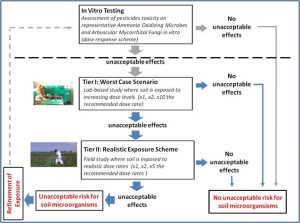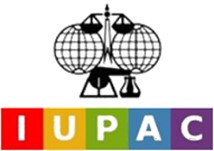Toxicity of pesticides onto non target organisms is an indispensable part of the pesticide regulatory framework. Although advanced protocols and tools have been developed and used for the assessment of the toxicity of pesticides on aquatic organisms and terrestrial macro-organisms this is not the case for soil microorganisms. Despite their pivotal role in soil ecosystem functioning, the assessment of the soil microbial toxicity of pesticides is still done using two out-of-date microbial tests, C and N transformation (OECD 217 and 216 respectively). Methodological advances have drastically changed the scene in soil microbiology. The implementation of ISO standardized tools in the environmental risk assessment of pesticides will enable the comprehensive assessment of the toxicity of pesticides on soil microbes. Our group has lead research work for the revision of the current regulatory framework and proposed new procedures for assessing the toxicity of pesticides on soil microorganisms. Arbuscular mycorrhizal (AM) fungi and ammonia-oxidizing microorganisms (AOM) are used as toxicity endpoints in a tiered assessment approach spanning from in-vitro testing (Tier I) to field experimentation (Tier III). Our current focus is:
(i) on the development of in vitro tests to accurately assess the toxicity of pesticides on AOM and AM fungi
(ii) on the study of the impact of pesticides on soil microorganisms looking at the food-web level (predators - prey system).

Our proposal for a tiered risk assessment approach to assess the toxicity of pesticides on soil microorganisms.
Collaborators: Our group is currently collaborating on this research axis with Dr Fabrice Martin-Laurent from INRAE-Dijon, other research groups in Europe and key industrial partners from the agrochemical sector like SYNGENTA, BAYER and METABOLIC INSIGHTS.
Funding
 ERA-NETplus, Development and implementation of innovative tools to estimate the ecotoxicological impact of low dose pesticide application in agriculture on soil functional microbial diversity (ECOFUN-MICROBIODIV) Funding: EU/DLR, Duration: 2010-2012, Coordinator UTH: Dimitrios Karpouzas
ERA-NETplus, Development and implementation of innovative tools to estimate the ecotoxicological impact of low dose pesticide application in agriculture on soil functional microbial diversity (ECOFUN-MICROBIODIV) Funding: EU/DLR, Duration: 2010-2012, Coordinator UTH: Dimitrios Karpouzas
 IAPP-MSCA-FP7, Pesticides – Felicity or curse for the soil microbes (LOVE-TO-HATE). Funding: 400000 €, Duration: 2013 – 2016, Coordinator: Dimitrios Karpouzas
IAPP-MSCA-FP7, Pesticides – Felicity or curse for the soil microbes (LOVE-TO-HATE). Funding: 400000 €, Duration: 2013 – 2016, Coordinator: Dimitrios Karpouzas
 CARIPLO project, Synthetic and Natural Agrochemical compounds: ecological impacts on the soil ecosystem and effects on plant production. Funding Body: The CARIPLO Foundation. Duration: 2012 – 2014, External Expert: Dimitrios Karpouzas
CARIPLO project, Synthetic and Natural Agrochemical compounds: ecological impacts on the soil ecosystem and effects on plant production. Funding Body: The CARIPLO Foundation. Duration: 2012 – 2014, External Expert: Dimitrios Karpouzas
 IUPAC project, Advances on the Assessment of Pesticides' Soil Microbial toxicity: New research and regulatory aspects in light of the recent methodological advances. Funding: IUPAC Division of the Environment, Duration: 2015 - 2020
IUPAC project, Advances on the Assessment of Pesticides' Soil Microbial toxicity: New research and regulatory aspects in light of the recent methodological advances. Funding: IUPAC Division of the Environment, Duration: 2015 - 2020
 MSCA-ITN-EID-H2020, The European Industry - Academia Network for RevIsing and Advancing the Assessment of the Soil Microbial TOxicity of Pesticides (ARISTO). Duration: 2020-2024, Funding Body: European Commission. Funding: 400000 €, Coordinator: Dimitrios Karpouzas
MSCA-ITN-EID-H2020, The European Industry - Academia Network for RevIsing and Advancing the Assessment of the Soil Microbial TOxicity of Pesticides (ARISTO). Duration: 2020-2024, Funding Body: European Commission. Funding: 400000 €, Coordinator: Dimitrios Karpouzas
![]() HFRI Call for the Support of Academia, Revolutionizing the assessment of the toxicity of pesticides on soil microorganisms: from single species tests to ecosystem approaches (ReASSESS). Funding Body: Hellenic Foundation for Research and Innovation, Duration: 2021-2023, Funding:185000 €. Coordinator: Dimitrios Karpouzas
HFRI Call for the Support of Academia, Revolutionizing the assessment of the toxicity of pesticides on soil microorganisms: from single species tests to ecosystem approaches (ReASSESS). Funding Body: Hellenic Foundation for Research and Innovation, Duration: 2021-2023, Funding:185000 €. Coordinator: Dimitrios Karpouzas
Publications
- Spyrou I.M., Karpouzas D.G., Menkissoglu-Spiroudi, U., (2009). Do botanical pesticides alter the structure of the soil microbial community. Microbial Ecology 58: 715-727
- Karpouzas D.G., Rousidou C., Papadopoulou K.K, Bekris F., Zervakis G., Singh B.K., Ehaliotis C., (2009). Effect of continuous olive mill wastewater applications, in the presence and absence of N fertilization, on the structure of rhizopshere soil fungal communities. FEMS Microbiology Ecology 70: 56-69
- Karpouzas, D.G., Singh B.K., (2009) Chapter 5: Application of fingerprinting molecular methods in bioremediation studies. In Bioremediation, Methods in Molecular Biology 599, Cummings S.P. Ed., Humana Press Inc., pp 69-88.
- Rousidou C., Papadopoulou KK., Zervakis G., Singh B.K., Ehaliotis C., Karpouzas, D.G., (2010) Fractioned land application of diluted olive mill wastewater induces changes in the structure of the soil microbial community. European Journal of Soil Biology 46: 34-4
- Karpouzas D.G., Ntougias S., Iskidou E., Rousidou C., Papadopoulou K.K., Zervakis G., Ehaliotis C., (2010) The effects of soil application of olive mill wastewaters on functional soil bacterial communities. Applied Soil Ecology 45: 101-111.
- Omirou, C. Rousidou, F. Bekris, K.K. Papadopoulou, C. Ehaliotis, U. Menkissoglu-Spiroudi, D.G. Karpouzas. (2011) Τhe impact of biofumigation and chemical fumigation methods on the structure and function of the soil microbial community. Microbial Ecology 61: 201-213
- Papadopoulou E.S., Karpouzas D.G., Menkissoglu-SpiroudiU., (2011) Extraction parameters significantly influence and the quantity and the profile of PLFAs extracted from soil. Microbial Ecology 62: 704-714
- Karpouzas D.G., Karatasas A., Spyridaki E., Rousidou C., Bekris F., Ehaliotis C., Papadopoulou K.K. (2011) Impact of a beneficial and of a pathogenic Fusarium strain on the fingerprinting-based structure of microbial communities in tomato (Lycopersicon esculentum) rhizosphere. European Journal of Soil Biology 47(6): 400-408
- Ipsilantis I., Samourelis C., Karpouzas D.G., (2012) The impact of biological pesticides on arbuscular mycorrhizal fungi. Soil Biology and Biochemistry 45: 147-155
- Puglisi E., Vasileiadis S., Demiris, C., Bassi D., Karpouzas D.G., Capri E., Cocconcelli PS., Trevisan M., (2012) Fungicides impact on the diversity and function of non-target ammonia oxidizing microorganisms residing in a litter soil cover. Microbial Ecology 64: 692-701
- Martin-Laurent F, Kandeler E., Pertic I, Djuric S, Karpouzas D.G., (2013) ECOFUN-MICROBIODIV: an FP7 European project for developing and evaluating innovative tools for assessing the impact of pesticides on soil functional microbial diversity-towards new pesticide registration regulation? Environmental Science and Pollution Research 20:1203-1205
- Rousidou C., Papadopoulou E., Kortsinidou M., Giannakou I.O., Singh B.K., Menkissoglu-Spiroudi, U., and Karpouzas D.G.,(2013) Bio-pesticides: Harmful or harmless to ammonia oxidizing microorganisms? The case of a Paecilomyces lilacinus-based nematicide. Soil Biology & Biochemistry 67:98-105
- Karpouzas D.G., Papadopoulou, E, Ipsilantis I., Petric I., Udikovic-Kolic N., Djuric S., Kandeler E., Menkissoglu-Spiroudi U., Martin-Laurent F., (2013) Effects of nicosulfuron on the abundance and diversity of arbuscular mycorrhizal fungi used as indicators of pesticide soil microbial toxicity. Ecological Indicators 39: 44-53
- Karpouzas, D.G., Kandeler, E., Bru, D., Friedel, I., Auer, Y., Kramer, S., Vasileiadis, S., Petric, I., Udikovic-Kolic, N., Djuric, S., Martin-Laurent, F. (2014) A tiered assessment approach based on standardized methods to estimate the impact of nicosulfuron on the abundance and function of the soil microbial community. Soil Biology and Biochemistry 75: 282-291
- Petric, I., Karpouzas, D.G., Bru, D., Udikovic-Kolic, N., Kandeler, E., Djuric, S.,Martin-Laurent, F (2016) Nicosulfuron application in agricultural soils drives the selection towards NS-tolerant microorganisms harboring various levels of sensitivity to nicosulfuron. Environmental Science and Pollution Research 23(5): 4320-4333
- Papadopoulou E.S., Tsachidou P., Sulowic S., Menkissoglu-Spiroudi U., Karpouzas D.G., (2016) Land spreading of wastewaters from the fruit packaging industry and potential effects on soil microbes: Effects of the antioxidant ethoxyquin and its metabolites on ammonia oxidizers. Applied and Environmental Microbiology 82: 747-755
- Papazlatani C., Rousidou C., Katsoula A., Kolyvas M., Genitsaris S., Papadopoulou K.K.., Karpouzas D.G., (2016) Assessment of the impact of the fumigant dimethyl disulfide on the dynamics of major fungal plant pathogens in greenhouse soils. European Journal of Plant Pathology 146 (2): 391-400
- Karpouzas D.G., Tsiamis G., Trevisan M., Ferrari F., Malandain C., Sibourg O. Martin-Laurent F., (2016) 'LOVE TO HATE'-Pesticides: Felicity or curse for the soil microbial community? An FP7 IAPP Marie Curie project aiming to establish tools for the assessment of the mechanisms controlling the interactions of pesticides with soil microorganisms. Environmental Science and Pollution Research 23:18947-18951
- Storck, V., Karpouzas D.G., Martin-Laurent F (2017) Towards a new pesticide registration policy. Science of the Total Environment 575: 1027-1033
- Storck V., Nikolaki S., Perruchon C., Chabanis C., Sacchi A., Pertile G., Baguelin C., Karas P.A., Spor A., Devers M., Papadopoulou E.S., Sibourg O., Malandain C., Trevisan M., Ferrari F., Karpouzas D.G., Tsiamis G., Martin-Laurent F. (2018). Lab to field assessment of the ecotoxicological impact of chlorpyrifos, isoproturon or tebuconazole on the diversity and composition of the soil bacterial community. Frontiers in Microbiology 9:1412. doi: 10.3389/fmicb.2018.01412
- Karas P.A., Baguelin C., Pertile G., Papadopoulou E.S., Nikolaki S., Storck V., Ferrari F., Trevisan M., Ferrarini A., Fornasier F., Vasileiadis S., Tsiamis G., Martin-Laurent F., Karpouzas D.G., (2018) Assessment of the impact of three pesticides on microbial dynamics and functions in a lab-to-field experimental approach. Science of the Total Environment 637-638: 636-646
- El Azhari, N., Dermou E., Barnard R.L., Storck V., Tourna M., Beguet J., Karas P., Lucini L., Rouard N., Botteri L., Ferrari F., Trevisan M., Karpouzas D.G., Martin-Laurent F., (2018) The dissipation and microbial ecotoxicity of tebuconazole and its transformation products in soil under standard laboratory and simulated winter conditions. Science of the Total Environment 637-638: 892-906
- Vasileiadis S., Puglisi E., Papadopoulou E.S., Pertile G., Suciu N., Papolla, A., Tourna M., Karas P.A., Papadimitriou F., Kasiotakis A, Ipsilanti N., Ferrarini A., Sulowic S., Fornasier F., Nicol G.W, Trevisan M., Karpouzas D.G (2018) Blame it on the metabolite: 3,5-dichloraniline rather than the parent compound iprodione induces strong effects on the diversity and function of soil microorganisms. Applied and Environmental Microbiology 84(22): e01536-18
- Gallego-Blanco S., Devers-Lamrani M., Rousidou K., Karpouzas D.G., Martin-Laurent F., (2019) Assessment of the effects of oxamyl on the bacterial community of an agricultural soil exhibiting enhanced biodegradation. Science of the Total Environment 651: 1189-1198
- Suciu N., Vasileiadis S., Puglisi E., Pertile G., Tourna M., Karas P.Α., Papolla, A., Ferrarini A., Sulowic S., Fornasier F., Trevisan M., Karpouzas D.G., (2019) Azadirachtin and trifloxystrobin had no inhibitory effects on key soil microbial functions even at high dose rates. Applied Soil Ecology 137: 29-38
- Katsoula A., Vasileiadis S., Sapountzi M., Karpouzas D.G., (2020) The response of soil and phyllosphere microbial communities to repeated application of the fungicide iprodione: Accelerated biodegradation or toxicity? FEMS Microbiology Ecology fiaa056, https://doi.org/10.1093/femsec/fiaa056
- Storck V., Gallego-Blanco S., Vasileiadis S., Begeut J., Rouard N., Hussain S., Baguelin C., Perruchon C., Devers-Lamrani M., Karpouzas D.G., Martin-Laurent F. (2020) Insights into the function and horizontal transfer of isoproturon degrading pdmAB genes in a biobed system. Applied and Environmental Microbiology 86 (14), e00474-20
- Sim J., Doolette C., Vasileiadis S., Drigo B., Donner E., Karpouzas D.G., Lombi E., (2021) Pesticides effect on nitrogen cycle related microbial functions and community structure. Science Total Environment submitted
Personnel
Dr. Panagiotis Karas, Postdoc Fellow
Alexandre Pedrinho, PhD student
Anna Manukyan, PhD student
Maria Kolovou, PhD student